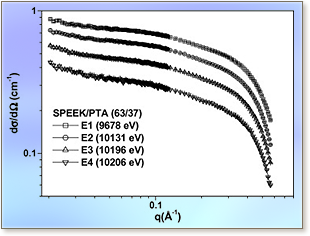Analysis of proton-conducting organic–inorganic hybrid materials based on sulphonated poly(ether ether ketone) and phosphotungstic acid via ASAXS and WAXS
L.A.S. de A. Prado, M. L. Ponce, G. Goerigk, S. S. Funari, V. M. Garamus, R. Willumeit, K.
Schulte, S.P. Nunes
J. Non-Crystalline Solids 355 (1), 6-11, (2009)

In the present paper the distribution of phosphotungstic acid (PTA, H3PW12O40) dispersed in sulfonated poly(ether ether ketone), SPEEK, was investigated by Anomalous Small Angle X-ray scattering (ASAXS) and Wide-Angle X-Ray Scattering WAXS techniques. The hydrolysis and condensation of 3-aminopropyltrimethoxysilane or zirconium tetrapropylate in this polymeric matrix were used to produce poly(3-aminopropyl silsesquioxane) or ZrO2, as nanofillers. Contrary to previous results reported for membranes containing phosphomolybdic acid, the PTA could be completely dissolved in the SPEEK matrix. The applicability of the Guinier approximation for the SPEEK/PTA membrane confirmed that the PTA was dispersed as isolated nanoparticles. The incorporation of poly(3-aminopropyl silsesquioxane) in the SPEEK/PTA system caused the agglomeration of the heteropolyacid as 30 nm large particles. The ZrO2 had little effect on the distribution of PTA in the SPEEK matrix. On the other hand, no crystallization of the heteropolyacid was observed in the membranes.